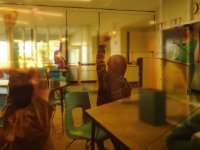“Creative Teacher” Is Not an Oxymoron
What is a creative teacher? There is no such thing as perfectly creative teacher or a non-creative teacher (Bramwell, Reilly, Lilly, Kronish & Chennabathni, 2011). The act of teaching demands creativity to answer the omnipresent question, "How am I going to engage the students this week?" This question weighs heavily on every teacher as he or she creates learning plans.
There is a perception that some teachers are gifted with natural creativity, and the rest of us have to beg and borrow to obtain creative ideas. I suspect that truly creative teachers are not so gifted in creation but they are masters at gleaning ideas from all kinds of sources.
Gifted or not, all teachers can use a dose of creativity to liven up the learning.
Where can teachers find creative ideas? Well, if you have a lot of time, you can sift through the mountains of horribly cute activities for coloring, connecting the dots, fill in the blanks, or other not-so-engaging worksheets found on websites. I propose a different tactic. Start with the masters of creativity: animated shorts. These little videos can be wonderful introductions to lesson topics -- interesting, engaging, and humorous. In most of these videos there are no words (satisfiying Robert Marzano's non-linguistic representation), so they work with basically all levels and multiple subjects.
Masters of Creativity
The video of two wildebeests contemplating crossing the river makes a spectacular lesson warm-up about decision-making, the art of persuasion, and the foibles of human nature (ahem, or biology). The "What If Animals Were Round" series of videos from Rollin' Wild can really spark student imagination. Pixar has numerous interesting shorts that teachers can use to grab students' attention. Some of my favorites are the old man playing chess or the unfriendly birds.
Characteristics of Creative Teachers
Once you have the student's attention, what do you do to keep it? Of course, experienced teachers have a few well-worn techniques in our teacher toolboxes, but new teachers are expected to provide the same levels of student interest with their quivers nearly empty. A study done by Bramwell et. al. (2011) suggests that creative teachers do similar things.
First, creative teachers not only learn about their own personal learning preferences and their students, they also tune into their colleagues' preferences. Creative teachers routinely customize their own learning activities and also glean and adapt techniques and strategies from their peers in order to reach particular sets of Howard Gardner's Multiple Intelligences.
I have found that I am most creative with things that interest me. When I teach the culture and history lessons on the ancient Mayans, I don't seem to have trouble finding creative learning activities. Finally, creative teachers value learning and interpersonal connections with students and their colleagues. Creative teachers deliberately spark interest, curiosity, and real-world application of knowledge through collaborating with fellow teachers and others.
Building a Creative Community
One of the biggest mistakes that new and experienced teachers make is trying to be creative on their own. Chatting with fellow teachers about ways to engage students can spark creative ideas that can become excellent learning experiences. Also, teachers often neglect to chat with administrators about their learning plans.
As teachers, we are connected to elements within our domain of the classroom and school. The most creative teachers also engage administrators to help in their creative projects, because administrators have wider connections and will gladly serve as liaisons to access the district and community resources.
Rather than being an oxymoron, the words "creative" and "teacher" are synonymous. Teachers are and should be creative masters at taking dull, monotonous learning objectives and making enticing, engaging learning activities. Teachers can seek inspiration from other creative masters and find volumes of "advice" and resources on the Internet, but some of the most important resources are found in the room next door and the office down the hall.
What is a creative idea for student learning that you've designed recently? Please share in the comments section below.
Reference
Bramwell, G., Reilly, R. C., Lilly, F. R., Kronish, N., & Chennabathni, R. (2011). Creative teachers. Roeper Review, 33(4), 228-238.
